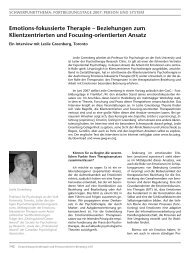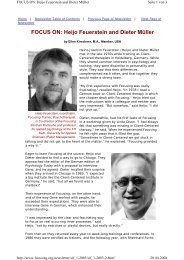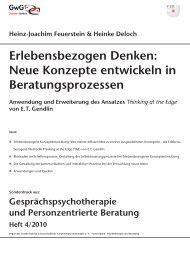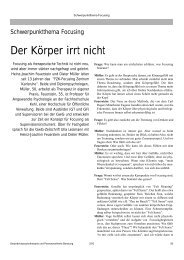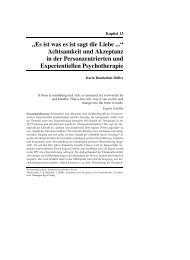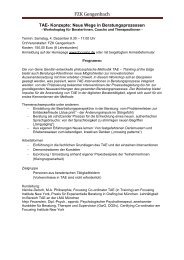Body-oriented interventions… - FOCUSING
Body-oriented interventions… - FOCUSING
Body-oriented interventions… - FOCUSING
Create successful ePaper yourself
Turn your PDF publications into a flip-book with our unique Google optimized e-Paper software.
Leijssen M., Nagels A. & Dekeyser M.: <strong>Body</strong>-<strong>oriented</strong> interventions in psychotherapy.<br />
2.6 Gestalt therapy<br />
As Existential psychotherapy and Interpersonal therapy, Gestalt therapy is a more directive<br />
and confronting form of experiential psychotherapy, where the therapist brings in the aspects<br />
the client tries to avoid or is not aware of.<br />
In the theory of Gestalt therapy, process is always seen as interchange between organism<br />
and environment. The body is the place of contact between field and organism. Interruption<br />
in contact is always a bodily interruption. Interruption of contact happens first of all by<br />
restricting ‘awareness’. The source of awareness is the body, namely senses, sensations<br />
and muscles. According to Gestalt therapy, psychological problems occur because the client<br />
disowns parts of the self. There is a split between the self-identified part and disowned part,<br />
which is the split in the verbal self and the body self. Disowning the body occurs by 1)<br />
preventing movements of disowned aspects by tightening muscles and 2) dulling or<br />
deadening bodily sensations. This prevents emotions which are threatening from coming into<br />
awareness. What was originally a conflict between self and environment becomes a split<br />
I/body.<br />
Opposite to the bodily knowing of the felt sense in focusing therapies, which is related to<br />
language, the body in Gestalt therapy is also approached apart from the verbal self.<br />
In the practice of Gestalt therapy, the therapist is looking very carefully at the body of the<br />
client which tells something more/else than the words of the client, and brings this in<br />
awareness: breathing stops, holding patterns (at the moment and through history), microactions,<br />
liveliness, color, warmth, development… of body parts, therapist body signals, bodyempathy,<br />
phenomenological interpretations, body-metaphors and sometimes bodywork…<br />
In Gestalt therapy, the integration of the disowned self starts with body-awareness and is<br />
further explored on a verbal or experimental level, with continuous attention to body process.<br />
2.7 Psychodrama<br />
Moreno developed Psychodrama from psychoanalysis and body action approaches. It is, like<br />
Pessotherapy, a form of group therapy where the interpersonal relation between client and<br />
therapist is different and less used as therapeutic tool as in the individual Experiential<br />
psychotherapies.<br />
For Moreno it is important to bring the body in action in stead of speaking about the problem.<br />
Action in role-play is seen as a way to discover new aspects of the self by action and<br />
interaction.<br />
In the practice of Psychodrama expression of emotions and experiments with new behavior<br />
are central.<br />
2.8 Pesso-therapy<br />
Al Pesso, a dancer from origin, is inspired by psychodynamic developmental theories. He<br />
states that basic needs are first of all body needs. The need for place for instance is met first<br />
of all bodily in the womb, then in the arms of the parents and only later on a more symbolic<br />
level by a place in the world. This is the same for the other basic needs like food, support,<br />
protection and limits. If not fulfilled on the physical level, later on they can not fully be<br />
experienced on a symbolic level.<br />
According to Pesso, the body remembers what didn’t took place and wants to fullfill the<br />
unmet needs. Pesso sees body contact necessary to complete the previous unmet needs.<br />
The aim of Pessotherapy is the formation of a more integrated memory around traumatic lifeevents.<br />
In Pessotherapy body signals and sensations of the client lead to previous unmet needs.<br />
One member of the Pessogroup takes the role of ‘witness figure’ and very carefully reflects<br />
what he sees at the body and face of the client, which is called ‘microtracking the body’. In<br />
the Pesso role-play or ‘structure’, other group members give the exact sensory and<br />
© 2003, Leijssen, Nagels & Dekeyser (U. Leuven, Belgium)<br />
Proceedings of the 15th International Focusing Conference 2003 Pforzheim/Germany, ed. by HJ Feuerstein,<br />
FZK Verlag, Weingarten (Baden), Germany<br />
4




